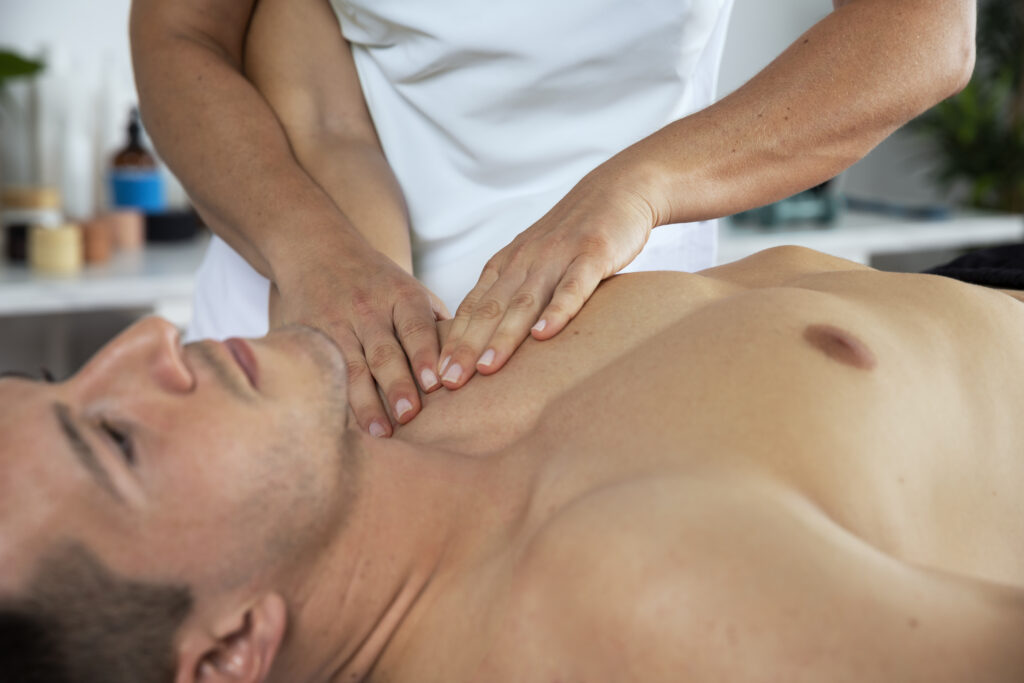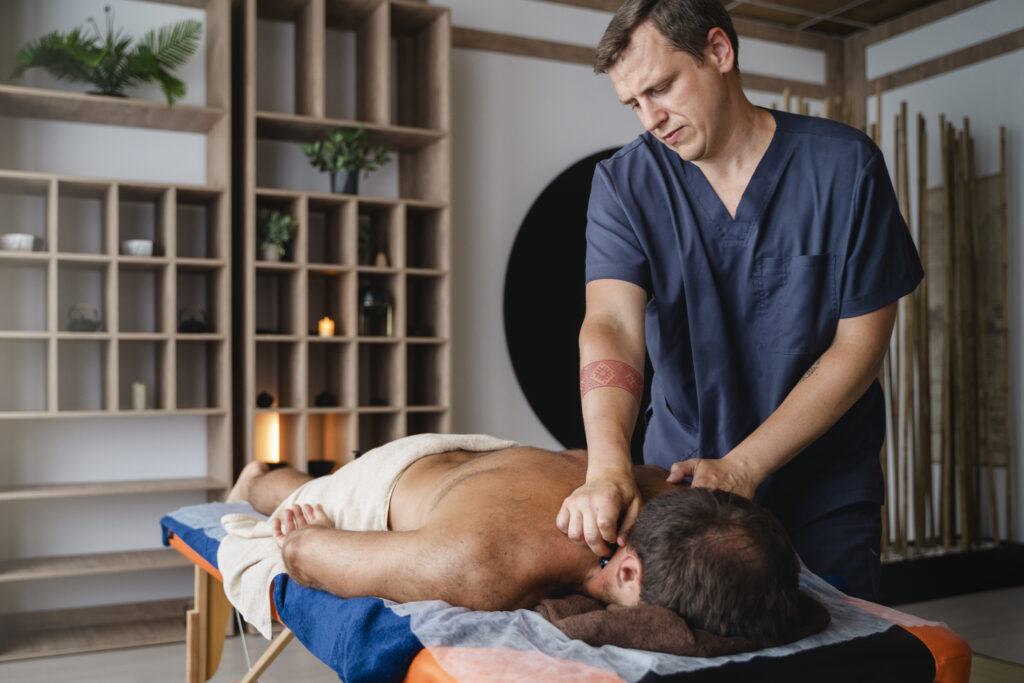Chest tightness can be an irritating sensation, but it may also be a cause for concern. It is often caused by muscle tension, bad posture, or a strain while breathing, which causes limited mobility and reduced quality of output breathing. Deep tissue massage therapy specifically targets these musculoskeletal causes to relieve chest tightness. In this blog, we will discuss the mechanism of how the deep tissue massage is extinguishing the chest tightness, the unification with the physical therapy, and the rationale for being a great treatment modality.

What Is Deep Tissue Massage for Chest Tightness?
Deep tissue massage is where you apply deep pressure to get into the deeper layers of muscle and connective tissue (fascia). All relief massages offer relaxation, but the deep tissue is different: rather than superficial, it intends to work into dissolving the knots and the scar tissue that keep your muscles and joints stuck in smaller ranges of movement. In cases of deep tissue massage for chest tightness , practitioners treat muscles that contribute to the mechanics of chest expansion and breathing, such as the pectoralis major and minor, intercostal muscles, and the musculature of the upper back.
How Does Deep Tissue Massage Relieve Chest Tightness?
Deep tissue massage for chest tightness uses slow, firm pressure and friction to release tight muscle fibers and fascia, improve blood flow, and increase the delivery of oxygen. These two benefit towards bigger lung capacity whilst reducing tightness in the chest, as they assist chest mobility and allow for more room in the rib cage. Indeed, some clinical studies validate that deep tissue massage promotes chest expansion and recipients obtain greater values of some key pulmonary capacities.
What Specific Techniques Are Used in Deep Tissue Massage for Chest Issues?
During your session, these techniques will vary but generally include the following in the treatment of chest tightness using deep tissue:
- Deep friction: used pressure in circular motions along muscle fibers to break down fibrous tissue and improve elasticity.)
- Trigger point therapy: Pressure on hyper-irritable areas of muscle that generate spasms and pain.
- Pushing and Pulling: Facilitated stretching of tense muscles and fascia to increase flexibility and relieve rigidity.
- Myofascial release: Gentle, sustained pressure to alleviate tight connective tissue surrounding muscles.
- Collectively, these interventions are directed against sites of restriction and ultimately enhance tissue compliance.
How Does Physical Therapy Complement Deep Tissue Massage?
Deep tissue massage often complements physical therapy to help heal you faster. Massage helps release tightness and adhesions in your muscles while physical therapy deep tissue massage strengthens weak muscles, improves posture, and stretches short and tight tissues. Since combined therapy directly improves breathing mechanics with postural realignment and respiratory muscle training, it may be more effective in providing long-term relief of chest tightness.
Is Deep Tissue Massage Safe for Chest Tightness?
Deep tissue massage therapy is considered safe for most people with musculoskeletal tightness in the chest area. Chest pain may indicate a severe medical problem, and thus it is important to exclude any basic cardiovascular or pulmonary aetiology before treatment. If you have heart or lung disease, get your health care provider’s advice before having a deep tissue massage.
What Should I Expect During a Deep Tissue Massage Session?
Sessions for chest tightness are typically conducted over 60 to 90 minutes. The therapist offering physical therapy deep tissue massage begins with slower strokes to warm tissues, and then presses deeper into your body by targeting areas of tightness or imbalance. It is normal to have some discomfort working through tight knots and adhesions, but pain should never be great. Expressing what feels right lets therapists safely modify pressure. Later on, you might experience soreness in your muscles, but this usually goes away within a day or two.
How Often Should I Get a Deep Tissue Massage for Chest Tightness?
Frequency depends on individual needs. If you’re dealing with chronic tightness, 3 to 6 weekly sessions typically yield meaningful improvement. These people often need maintenance treatments every few weeks to relieve persistent tension. Integrating massage with at-home exercises from physical therapy can increase and prolong the benefits.
Can Deep Tissue Massage Help Improve Breathing and Lung Function?
Yes. Deep tissue massage therapy helps to release restrictions of the muscles and fascia of the chest wall, allowing for fuller expansion of the chest wall during respiration. In clinical studies, with a greater chest level and improved important lung capacity could be seen after the remedy that allows the frame to absorb air greater effectively and breathe higher.

What Are the Key Benefits of Deep Tissue Massage for Chest Tightness?
- Helps to break down scar tissue that can lead to pain and stiffness
- Increases chest wall function and lung volume
- Increases oxygen transport to tissues and blood flow
- Allows essential recovery from injury or stiffness from surgery to be quicker
- Decreases muscle tightness and reinforces better posture
- Promotes relaxation and stress reduction
Key Takeaways
- Specifically, deep tissue massage will help release deep muscular and fascial tension that may be causing tightness in the chest.
- It also increases the chest hyper and the working of breathing through better muscle elasticity and circulation.
- They incorporate physical therapy to improve posture, breathing mechanics, and prognosis.
- The therapy is safe, and the only post-session soreness is typically due to working on your muscle tissue, and this treatment should always be individualized.
- There is scientific research to support its benefits to muscular and respiratory parameters.
Frequently Asked Questions
Will deep tissue massage relieve my chest tightness if anxiety and stress are to blame?
Yes. The chest tightness comes from muscle tension due to stress. Deep tissue massage relaxes these muscles and activates the parasympathetic nervous system, which can help reduce anxiety symptoms.
If you feel pain after a deep tissue session, how deep is it?
It is common to have mild to moderate soreness in response to undoing tight tissues, but that generally resolves within 24-48 hours.
Are there any side effects?
A qualified therapist minimizes risks and most often, only minimal bruises or symptoms occur, which are resolved.
What is the difference between a deep tissue massage and a Swedish massage?
Swedish massage often uses lighter and more superficial strokes to promote relaxation, while deep tissue massage focuses on deeper layers of muscle and treat with more specific and intense pressure.
Is it safe to integrate deep tissue massage with other treatments?
Yes, it usually complements well with physical therapy, chiropractic, and stretching exercises to optimize recovery.
Experience Deep Healing at Mali Healing Spa NYC
Chest tightness should never stop you from enjoying the comforts of life and breathing freely fortunately, deep tissue massage coupled with proper physical therapy monitoring may restore your comfort and quality of living. At Mali Healing Spa NYC, expert therapists specialize in customized deep tissue rituals aimed at restoring mobility of the chest and reducing muscular tension in the areas surrounding the rib cage while promoting easier breathing. Call for bookings today and let Mali Healing Spa NYC ease your breath.




